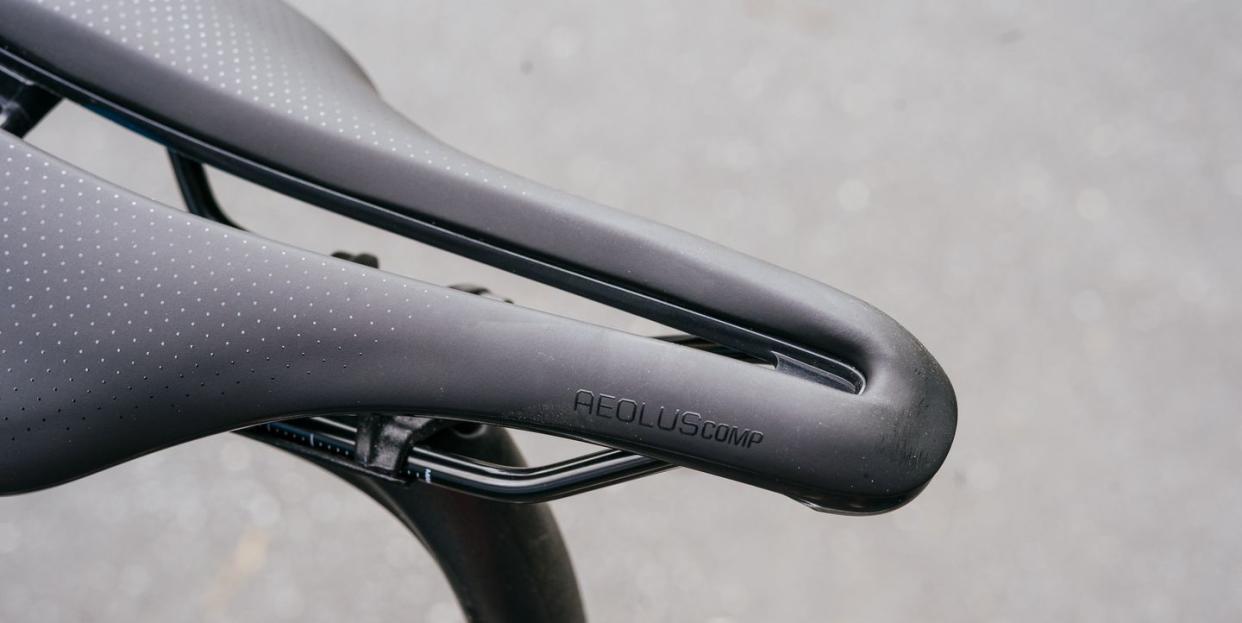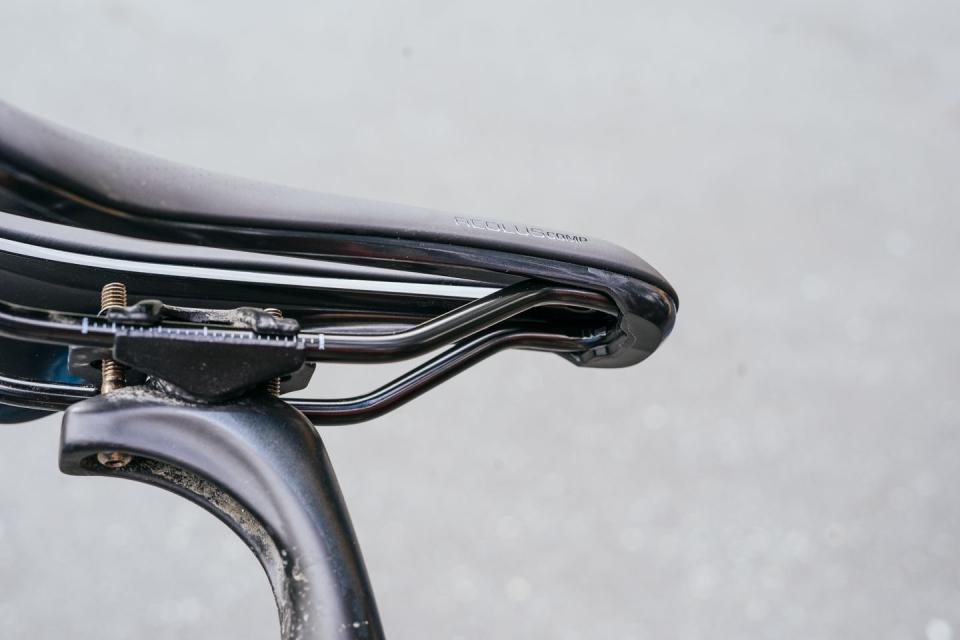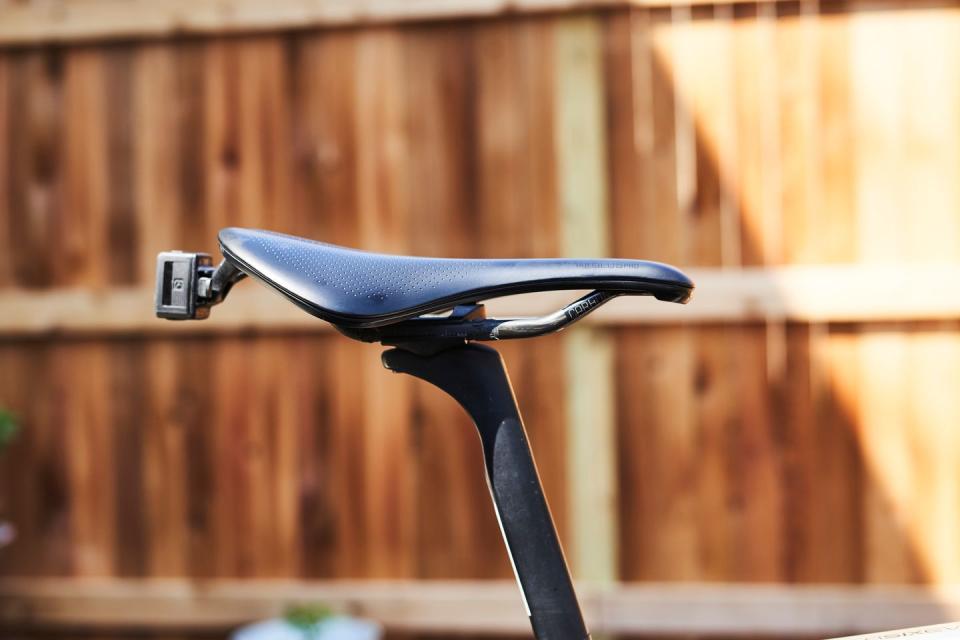Short, But Long on Performance: Bontrager’s Aeolus Comp

The Takeaway: The Bontrager Aeolus Comp is comfortable in aggressive and relaxed riding positions and costs less than most short saddles.
Wide cutout relieves pressure
“Scoop” at the rear of the saddle helps you power up climbs
Shell flexes slightly, smoothing out bumps
Price: $90
Weight: 290g (155mm)
Width: 155mm (also available in 145mm)
It’s no surprise that Bontrager threw its hat into the ring of the stubby saddle; the company likes to offer every component on a bicycle and the short saddle is having a moment of popularity. At first glance you can see a striking resemblance to the “Pro Stealth” saddle from Shimano, with a similar short and wide nose shape and overall profile. This is a shape that many, myself included, have come to know and love, so my hopes were high for the Aeolus. I’ve tried the popular Specialized Power Expert saddle and found it too finicky to set up. The issue I had with the Power is that it seems to be a one-position saddle, not allowing for much moving around while riding. Also, the nose offers little support when on the rivet.
Being someone that prefers to move around a little more, I looked for something with more support. I eventually found myself at home on the Pro Stealth, with a wider nose, ample relief channel to keep comfortable while powering on the nose and a nice base to push against on steep climbs. The Bontrager Aeolus saddle checks all the same boxes that I look for in a saddle so I was excited to find out how I’d get along with it.

Ride Impressions
Initially, I didn’t notice anything different than my regular saddle, a good sign considering I like my current setup. One place the Aeolus deviates from my Pro Stealth Saddle is the inclusion of a slightly larger “scoop” on the rear end. At first it wasn’t noticeable, but on longer climbs and powerful efforts in the saddle, the curve offers a bit more support and a sense of being locked in that I grew to appreciate. I’ve put the Aeolus Comp and Pro through their paces from extended hard efforts in the drops to seemingly never ending 11-percent grades and in all scenarios I never once thought about my saddle. The only time I did think about the saddle was when it made a slight creaking noise while I shifted my weight around. The occasional creaking is the only real negative I’ve found, besides being on the heavy side at 290 grams. If weight is a concern, Bontrager offers lighter versions; more on those later. Another nice touch is that the rails anchor at the very ends of the saddle, allowing a decent amount of flex in the shell—not in an annoying way but in a ride-smoothing, added comfort kind of way.
On Trend (For Good Reason)
There is no denying the short, stubby saddle is here to stay. We are seeing more and more fitters opting to put riders on this style of saddle in hopes of finding relief. Before I go on, I will acknowledge the fact that saddles are highly personal and although one rider may find one saddle comfortable, another may find it unbearable. For example, I have no idea how people ride on super flat, narrow saddles—just perplexing to me—while you might feel the same way about saddles with a pressure relief channel. If you are someone who doesn’t get along with cutout saddles, feel free to navigate away from this review.
I have a theory that even if you don’t think you need a relief channel or a cutout, you should still try a saddle with one. It can’t hurt to have a little extra relief on your sensitive parts. If you have a favorite saddle, there is a good chance you can find a similar one with a cutout because many brands now offer their popular saddle shapes with the added benefit of a cutout. The stubby saddle’s growth in popularity is no coincidence: No one likes numb bits.

Aeolus Family
The saddle comes in two widths, 145mm and 155mm (tested), and three build levels, Pro, Elite, and Comp. With the nose profile unchanged from width to width, I’ve found that I can ride comfortably on a narrow saddle like the 142mm Stealth but also the 155mm Bontrager. With that said, the wider Aeolus offered better support for my sitbones when in a more upright position. If you are looking to buy a new saddle, it’s always recommended that you try different widths before committing to a purchase to make sure you’ve found the right fit. All the Aeolus saddles come with the option of adding an integrated mount for the Flare line of lights. The mount is sleek and stays out of the way of a saddle pack, while being highly visible.
As stated earlier, the Comp version is definitely on the heavy side. But at $89, the price is much easier to handle than the $230 range-topping pro version. I’d be tempted to splurge and go for the 100-gram-lighter Aeolus Pro, but in reality would settle in the middle with a 67-gram savings on the Elite and keep a few extra dollars for lunch.

No matter how you slice it there is a Aeolus saddle that should match your price point and fit. If you are a rider who feels that you might benefit from a cutout, you should certainly consider the Aeolus family of saddles. From all-out efforts on the rivet to 6+ hour dirt road adventures, I have yet to really think about the Aeolus while riding my bike. To me, that is the sign of a great saddle.
You Might Also Like

